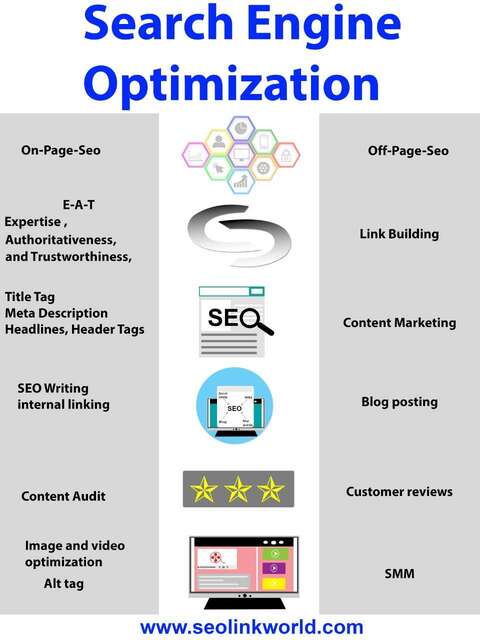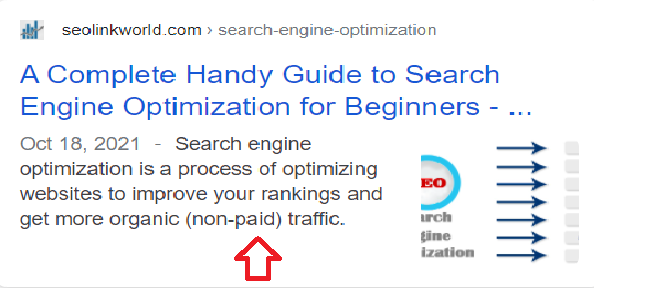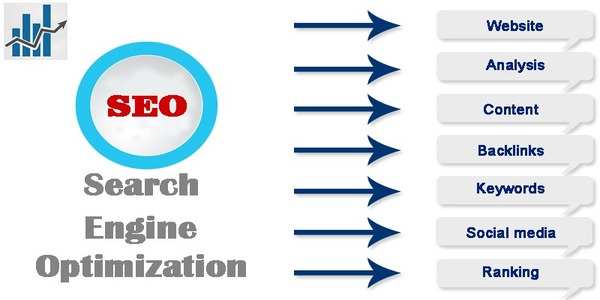Search Engine Optimization or SEO, you can easily find a simple definition of this term. But you need to understand the complete process to perform the tactics. SEO practices are basically used to improve the visibility of your content.
So, you need to understand several terms. Such as optimizing and writing content for search engines and users. And increasing a site’s organic search visibility, what are good SEO and bad SEO? How to drive more relevant traffic? All these questions and terms need to be understood.
So, let’s understand the definition first. Search engine optimization is a process of optimizing to improve website rankings. And get more organic (non-paid) traffic. Now, this traffic can be beneficial in growing your business.
But, also, it can help you in growing a targeted audience with high-intent traffic. So, what exactly do you exactly need to do to increase organic traffic.
Table of contents
Basics of Search Engine Optimization
The first thing that you need to understand is that Google is responsible for most of the search engine traffic in the world. It is a known fact that Google is the dominant player in search results; it carries over 64% of overall traffic.
There is a gamut of ways by which you can get your pages to rank in top searches. Google’s algorithm is quite complex. And it basically depends on the relevant information and quality of SEO content.
The content needs to be visible in the search engine to show up in search results. It is a fact that if your site can’t be found. Then it is quite hard for your content to ever show up in the SERPs (Search Engine Results Pages). Search engines usually have three main functions:
- Crawling: Finding content on the internet is called crawling. In this process, Google or another search engine sends bots to web pages to find the content.
- Indexing: It is the process of storing and organizing the content found during the process of crawling. So once a page is indexed, it’s ready to be displayed as a result of relevant queries.
- Ranking: Depending on the quality of the content, the best answer will be fetched. It also depends on the results ordered from most relevant to least relevant.
Understanding the Search Engine Functions
Crawling
Crawling is the process of discovery in which a search engine prepares a team of robots. And sends them to find content (known as spiders or crawlers). It could be a webpage, post, image, document, video, PDF, etc. The crawler fetches links to find the result. And these bots follow the link on those web pages to find new URLs.
The crawlers hop to all relevant pages; after finding new content, they add it to their Caffeine index. The crawler maintains a massive database of discovered URLs. After that, whenever someone searches for these pages. the crawler retrieves information that the content on that URL is a good match for.
Indexing
After crawling, the fetched links will be stored and organized as an index. This will form a huge database of all the content. The crawler indexes enough links to serve up to searchers. Google is responsible for indexing. So basically, it adds web pages to Google search that will help in finding results quickly. A no-index tag means that a page, image, doc, or post will not be added to the web search index.
Ranking
When you search, search engines look into their index and find highly relevant content. After that, it orders that content and solves the query. This relevancy of ordering search results is known as ranking. In general, it is simply the higher the website ranked. the more relevant the search engine will find the result.
It’s possible to block crawlers of search engines from your site. You can also instruct search engines that can avoid storing certain pages in their index. However, it is required that your content is accessible to crawlers and indexable. If the content is not accessible, it will not be visible.
So, all this summarizes making sure your site gets crawled and indexed. Only that will help in showing up pages in the SERPs.
Targeting Best Practices:
This involves finding target keywords. This involves identifying target people for your content, and for that, you need to use some different types of SEO. Researching these keywords involves some common key factors.
- Search Volume – One of the main factors that need to be considered in keyword research. And how many people (if any) are searching for a given keyword. It is simply that the more searches’ people, the bigger the audience and the bigger the reach. So, you need to look for the volume because you will have no audience if the search is low, which affects your goals.
- Relevance – The number of searches is not the only thing that matters—the keywords are required to be relevant. You need to find the most relevant keywords that will help in bringing traffic. It would help if you found keywords that are in the interest of searchers. Long-tail keywords are also entirely irrelevant. An essential that will help in fetching more traffic and growing your business.
- Competition – Competition is one of the critical factors that you need to consider. In SEO, you have to look for potential costs and the likelihood of success. This means understanding the relative competition for specific terms.
You need to understand your audience, which includes understanding what they want. the type of things they are searching for, and what more value you can offer. When you find answers to all these questions, you will know what types of keywords you need.
Use SEO tools
SEO tools will help you in finding the keywords that need to be targeted. So, to search for keywords, you need to have a keyword tool. There are free and paid tools that you can use to find the keywords.
- Google keywords planner
- Uber suggest
- Wordstream
- Mangools
- Moz
These are some of the best tools and metrics for tracking SEO performance that one can use to fetch keywords. First, you can find a comprehensive list of keywords. Now, while fetching the keywords, you need to look for their volume and competition. You can also use these tools to find your competitors’ keywords on which their pages are ranking.
The paid version of some keyword searching tools gives you an insight into your competitor’s complete website or blog. Tools like ahrefs, SEMrush, and Moz can be some of the top choices. Such tools will also help in finding content ideas for your webpage.
Optimization
Search engine optimization works in two ways: On-page SEO and Off-page SEO. The on-page SEO is the next step that needs to be taken to implement the targeted keywords. And choose the best SEO keywords to optimize your website and know the keyword difficulty. It is the basic practice of optimizing web pages for specific keywords. This practice helps to improve the search visibility and traffic of your webpage. It involves things like headings, content, internal links, title tags, etc to optimize your blog for SEO.

Google uses the title tag process to understand the webpage. And it means you can’t put keywords aggressively. One of the single most impactful places to put your keyword is your page’s title tag. It is not the main title of your page.
Instead, you will see the title at the top of your browser and is populated by your page’s source code in a meta tag. It is advised to keep the title tag length between 55 to 60 characters. Try to form your title tag with keywords and some related modifiers around the term.
Meta Description
The meta description is quite essential for your site and works as an additional ad copy. It depends on what Google displays in search results. In this case, the meta description may not always show. But, if you have a compelling description that makes folks searching likely to click. Then you can significantly increase traffic.

Content
The body of the content also plays a vital role in searching for the page. Several factors need to be kept in mind while framing and writing your content. First, the content needs to be write SEO-friendly content that is informative and unique. Second, you need to put some valuable information in the body. That will help to engage the audience and build content authority.
Engaging the audience is also important because Google is now showing the content on top of which the user spends more time. In addition, the content is shown as simple and unique and can be shared with more public. This will help bring more traffic and a long-term audience.
URL Structure
The URL structure of your site is also fundamental because it helps in tracking. (you can more easily segment data in reports) and shareability standpoint. It is always better to create a short and descriptive (slug) URL. You need to have a proper URL structure and follow all best practices for URLs.
Internal Linking
One of the most important parts of an on-page SEO checklist. Linking your old and new articles with each other is quite helpful. This will improve your website’s traffic, along with this. It will help build the content authority to make a good website.
In addition, interlinking your content can impact the ranking of pages. For example, you were interlinking some specific pages aggressively from various areas on your site. This will indicate to search engines that that specific page is significant to your site.
You need to know about your most crucial search pages. This will help in driving traffic to all other blogs. This means linking to them often in navigation elements. Linking to them whenever possible from your most linked-to pages can help. Link building is quite important, having quality links to your site help in driving search traffic.
Content Marketing
There are ways to get backlinks to your site, but search engines are becoming more sophisticated. If you are new to SEO, creating links to manipulate Google rankings doesn’t value your business. This practice of search engine algorithms shifts your rankings, and it may disappear.
We need to use a sustainable marketing approach to develop links and attract more traffic. You need to create quality and effective content to get discovered. This will also improve the rank of your page gradually.
You also need to look for people who can link your content and share your content. You can use tools that will help you identify the influencer. These influencers of your niche will share your content if they find it valuable and helpful. So, you need to create content that will help these influencers to grab some traffic from you.
It works both ways, and you will be helping each other grow if you can create content consistently in your blogging. Then gradually, you’ll start to build powerful relationships. This will pay dividends as you create content and help you grow.
Common Technical SEO Issues
SEO will help in driving traffic and improving your business authority and ranking. However, traditional search engine optimization practices still generate traffic. As keyword search is still valuable. While performing these practices, there are chances that you’ll make some common mistakes. Below, we have listed some of the common technical SEO issues that you need to avoid.
Page Speed
Search engines promote pages that are fast and quick in response. Having fast-loading sites will be beneficial for search engines. But it will also help improve conversion rates. Google has created a useful tool that gives suggestions on what to change on your site. Using these tools, you can optimize the speed of your page.
Other than this, you will have some simple tricks that you can use to improve the speed. Such as using a small size, high-quality images, and others. Users want to access the page as quickly as possible. And if it continues to load for a long time, you may lose your traffic.
Mobile Friendliness
People use mobile phones more than any other device. Driving significant search engine traffic from mobile searches. And shows how mobile-friendly your site is. This will directly impact your rankings on mobile devices.
We all know that mobile surfing is a fast-growing segment. And in today’s time, most of the mobile traffic already outweighs desktop traffic. Google is also updating algorithms and focusing more on mobile search engine traffic. If your website is not mobile-friendly, it can be quite hard to drive traffic and improve ranking.
Header Response
Header response codes are some of the major technical SEO issues. If you’re not particularly technical, this can be complex to understand. You first need to ensure that the working pages return the correct code to search engines (200).
Some pages are also returning code (404) to represent they are no longer present. These common header responses or issues like ‘Page not found’ can be problematic to users. It might indicate to Google that all your website content is 404s. Now, this means that Google thinks that none of your pages are indexed.
Duplicate Content
Duplicity always creates problems; you are diluting link equity between two pages. Keeping the same content as some other domain name will affect your domain authority. And the originality of your content.
It will give you less of a chance of ranking for competitive phrases. Having large quantities of copied content makes your site lower quality. And search engines might not help in ranking your pages.
Many things can cause the copying of content. People don’t know, but knowingly or unknowingly, they use duplicate content. Also, these are hard to diagnose. But you can use webmaster Tools under Search Appearance > HTML Improvements to get a quick diagnosis.
XML Sitemap
XML sitemaps help search engines such as Google and Bing to understand your site. This will help them in finding all its content. You need to make sure not to include pages that aren’t useful. XML is just away, and it doesn’t ensure that submitting a page to a search engine will rank for anything. There are many free tools to generate XML sitemaps.
Measure SEO Result
As you create quality and valuable content for search engine optimization. And put all your efforts into blowing the public’s mind. How do you understand or measure that it is working? So, you need to focus on some key SEO metrics and analyze the SEO performance.
The first thing you can start with is keyword ranking. Personalization in search results has made pages variable across different locations. Therefore it is hard to track, and some would even declare them dead. But you need to find the core terms of your site that can be a useful leading indicator to improve your site’s health. High rankings across a range of keywords are a strong indicator of organic search visibility.
Organic traffic is one of the best ways to measure how your site is performing. It is the best way to examine the health of your website. You can use various SEO tools to find out the amount of organic traffic your website is getting. This can also help in knowing and improving your content and SEO practices to index website on Google.
Related Topics
- Search Engine Marketing
- What is Local Listing in SEO?
- Difference Between SEO and SEM
- Alternative Search Engines
- Google vs. DuckDuckGo
- Advantages of Internet Marketing
- Video Search Engines
- Shopping Search Engine
- Benefits of Using Long-Tail Keywords in SEO
- How To Get Quality Backlinks
- Google Search Console Guide
